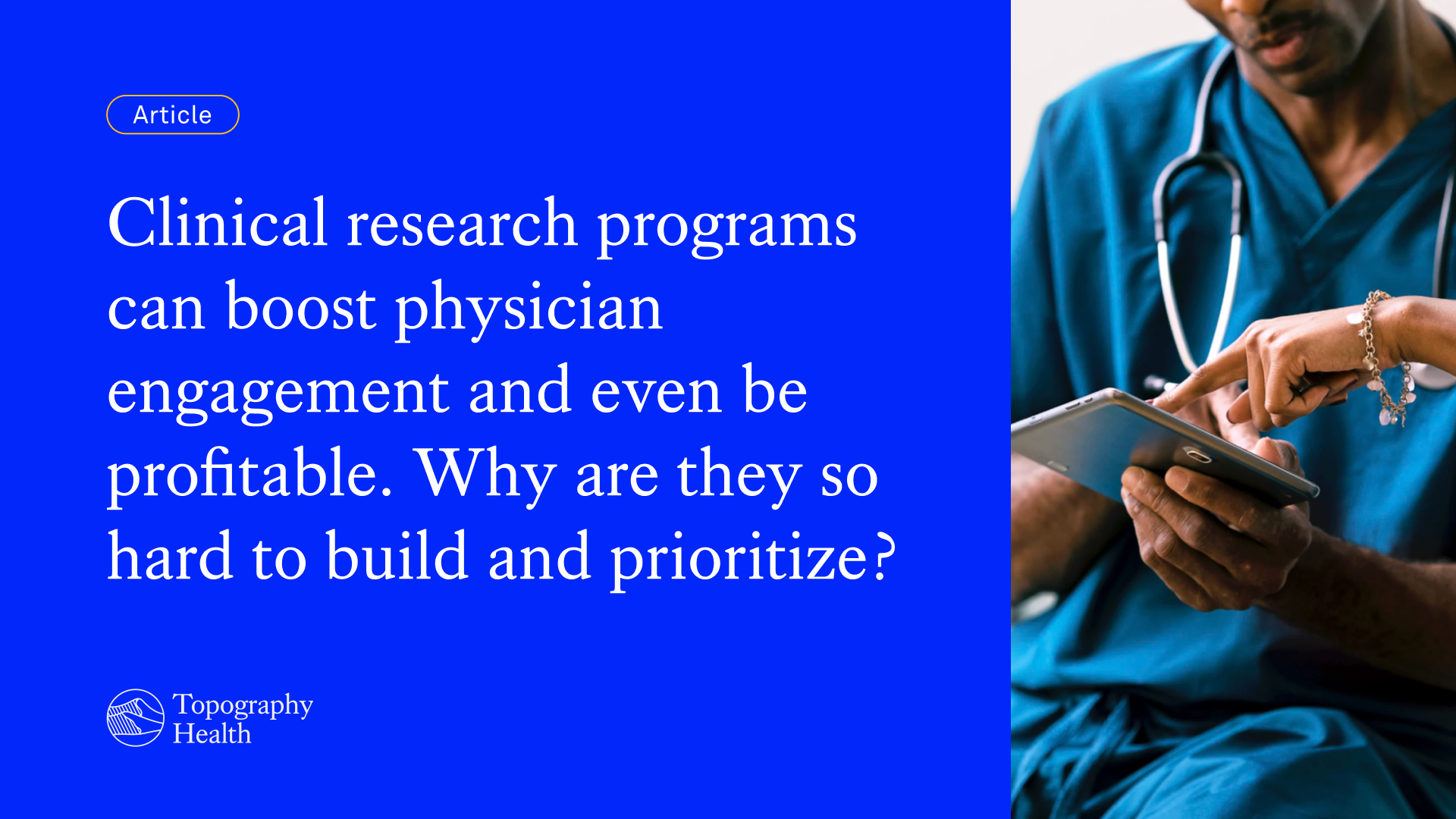Clinical research programs can boost physician engagement and even be profitable. Why are they so hard to build and prioritize?
The past several years — particularly in the wake of the COVID-19 pandemic — have revealed great enthusiasm around clinical research from both physicians and patients. Physicians are interested in conducting research to engage in the learning and science that brought them into medicine originally, and patients want access to trials that in many cases can be life-saving. We hear these stories every day from the practices and systems we work with. With so much enthusiasm, why aren’t more practices and systems running successful research programs? And why is it so hard for so many patients to find trials that are accessible and close to where they live?
We conducted a survey of CFOs, COOs, and administrators from practices and systems around the country, to gain an even deeper understanding of the research landscape.
Here’s what we found.
Practices and systems need support to generate consistent revenue with research
Clinical research is often seen as a cost center rather than a revenue driver. While profitability is possible, driving consistent revenue over time remains a steep challenge, even for those who have built an otherwise successful research program. Most respondents believe the right resources and guidance can help them build research programs that provide reliable revenue streams.
- Nearly 60% of administrators running research programs would consider partnering to enhance their program.
- 75% of practices and systems surveyed reported generating profits over the past five years, across clinics of all sizes — from single-provider practices to large healthcare systems. Even if profitable, they’re unable to drive revenue repeatedly and reliably.
- Financial viability is critical when expanding research capabilities. Most surveyed leaders identified revenue growth as a primary driver, alongside patient satisfaction and physician engagement.
Research is an edge case as an ancillary and falls outside the core standard of care, so the high costs and operational intensity involved mean it’s often not prioritized, despite the potential revenue opportunity. Across our survey, we saw leaders highlight staffing costs, start-up expenses, and ongoing financial uncertainty as major barriers when it comes to research. It’s these challenges that illustrate why practices and systems need partners to help them build a program. The right partners can significantly lower the barriers to entry, manage the financial risks, streamline operations and help integrate the right technology. All make it easier for systems to realize the benefits of research without shouldering the entire burden.
Physician engagement is the key to long-term success
Overall, physician engagement rises to the top as one of the most important aspects of building a successful research program. What we heard:
- More than 75% of healthcare leaders surveyed believe research enhances both patient satisfaction and physician engagement.
- When run well, research is seen as a fulfilling addition to clinical practice, not an added burden.
- Engaged physicians are more likely to champion research programs and integrate them into their practice.
Ultimately, building a successful research program means engaging physicians in research as both a professional learning opportunity and a path to better patient outcomes. Institutions that prioritize the physician experience from the outset are far more likely to have a meaningful impact in their communities.
AI is still an untapped opportunity, despite the hype
AI has transformative potential and lots of hype within the medical community, but adoption in clinical trials remains minimal. Only 4% of surveyed leaders identified AI as part of their current or future research strategy.
AI can provide powerful solutions in trials, but it’s all about how it’s deployed. For example, AI can automate time-consuming processes such as patient recruitment, data analysis, and trial monitoring. It has an important role to play in speeding up the process and ensuring success, but it’s hard for many leaders to know where to start.
One challenge is that many technology offerings are point solutions, addressing just one sliver of the problem and not taking the overall framework of trials into account. Most practices and systems are not factoring AI in at all, let alone looking at the AI-driven research services out there that might help them integrate the best tools with the support they need across the tech and operations stack when it comes to research.
Taking these findings forward
Clinical research can be a major opportunity for practices and systems to generate consistent revenue, provide new care opportunities for patients and provide physicians with meaningful learning experiences. While challenges like startup costs and operational complexity are steep, they can be overcome with the right approach and partners.
As we move into the future, the combination of physician enthusiasm and patient awareness make it more likely that research will take place at the point of care — within a community practice or system — rather than an academic institution. As the data shows, service partners are needed to achieve this.
Many leaders in the research space are aligned with this vision. The Journal of the American Medical Association recently published a piece, Advancing a National Infrastructure for Clinical Trials, calling for a new trials infrastructure that can help address the challenges that practices and systems face pointing to the challenging state of trial financing and organization as obstacles to expansion.
Interested in building or expanding your research program? Contact us to learn how Topography Health can help.












